
The Nissan Pathfinder is a range of sport utility vehicles manufactured by Nissan since 1985. Until the third-generation model, the Pathfinder is based on Nissan's compact pickup truck platform which it shares with the Navara/Frontier. The front end of the D21 and R51 Pathfinder is notably identical with the Navara/Frontier up until the B-pillars.

The Nissan Navara is a nameplate used for Nissan pickup trucks with D21, D22, D40 and D23 model codes. The nameplate has been used in Australia, New Zealand, Central America, South America, Asia, Europe, and South Africa. In North, Central and South America and some selected markets, it is marketed as the Nissan Frontier or Nissan NP300.
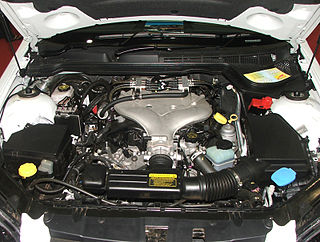
The GM High Feature engine is a family of modern DOHC V6 engines produced by General Motors. The series was introduced in 2004 with the Cadillac CTS and the Holden Commodore (VZ).

Mazda has a long history of building its own diesel engines, with the exception of a few units that were built under license.

The Infiniti M is a line of mid-size luxury (executive) cars from the Infiniti luxury division of Nissan. From 2013 on it has been marketed as the Infiniti Q70, reflecting the company's new naming scheme.

The VK engine is a V8 piston engine from Nissan. It is an aluminum DOHC 4-valve design.

The VQ is a family of V6 automobile petrol engines developed by Nissan and produced in displacements varying from 2.0 L to 4.0 L. Designed to replace the VG series, the all-aluminium 4-valve per cylinder DOHC design debuted with Nissan's EGI/ECCS sequential multi-point fuel injection (MPFI) system. Changes from the VG engine include switching to a timing chain from a timing belt, and relocating the water pump from the outside of the engine to inside the timing cover where the pump is driven by the timing chain. Later versions featured various improvements, such as variable valve timing, and NEO-Di designated VQ engines replace MPFI with direct fuel injection.

The VG engine is a family of V6 engines designed and produced by Nissan between 1983 and 2004.

The QR family of inline-four piston engines by Nissan were introduced in 2000 and range from 2.0 to 2.5 L in displacement. These motors are aluminum, dual overhead camshaft (DOHC), four-valve designs with variable valve timing and optional direct injection. The engine shares much of its architecture with the YD diesel engine.
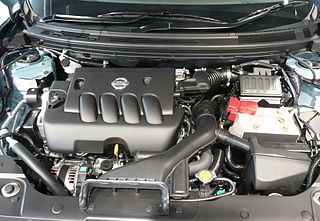
The Renault-Nissan MR engine family consists of straight-four 16-valve all-aluminium and water cooled automobile engines with variable valve timing co-developed by Renault and Nissan. Renault calls it the M engine. Other noteworthy features of this engine family include acoustically equal runner lengths and a tumble control valve for the intake manifold, a "silent" timing chain, mirror finished crankshaft and camshaft journals, and offset cylinder placement in an attempt for increased efficiency.

The Infiniti G Line is a series of compact executive cars produced by Infiniti, a luxury division of Nissan, for the 1991–1996 and 1999–2016 model years. The first two generations of the Infiniti G were sedans based on the Nissan Primera. Beginning with its third generation (V35), the Infiniti G have been rebadged versions of the Nissan Skyline line of sedans and coupes that were exported to the United States and Canada. The final incarnation is the fourth generation (V36) which introduced the hardtop coupe convertible. The Nissan FM platform, on top of which the third and fourth generations of the Infiniti G have been built, also underpins the Nissan 370Z and has shared components with the Infiniti M, Infiniti EX, and Infiniti FX.

The Volkswagen Taro 1 tonne pickup truck was introduced in January 1989 by Volkswagen Commercial Vehicles to complement the half tonne Caddy pickup / panel van ranges, and the 1 tonne Transporter van and chassis cab ranges. The name "tarō" is a suffix used in Japanese to denote the oldest brother or son, or the first-born son of a family.

The Renault DiET engine also known as "D engine" or "D-Type" is a straight-4 automobile petrol engine from Renault designed to replace the existing Cléon-Fonte engine in the Renault Twingo.
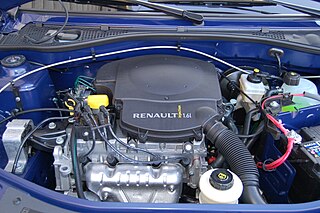
The K-Type is a family of inline-4 automobile engines developed and produced by Renault since 1995. This is an internal combustion engine, four-stroke, with 4 cylinders in line bored directly into the iron block, water cooled, with tree (s) driven overhead camshafts driven by a toothed timing belt and an aluminium cylinder head. This engine is available in petrol and diesel versions, with 8 or 16 valves.

The R-Type is a family of straight-4 turbocharged diesel engines developed by both Nissan and Renault, and also Daimler in regarding the R9M/OM626 engine. Released in 2011, it replaced the 1.9 dCi engine in Renault's range and the 2.0 dCi in the Nissan Qashqai, and in 2015, it also replaced the 2.0 dCi in the Renault Mégane as well. When launched, the engine produced 130 PS. Renault later introduced a higher-powered twin-turbocharged variant producing 160 PS.

The N series is Honda's first automotive diesel engine, an inline-four for medium-sized vehicles. It uses common rail direct injection, which Honda brands as i-CTDi. The most notable feature is the aluminium block, which uses proprietary technology in the manufacturing process to provide light weight and high rigidity. Roller chains drive two overhead camshafts. A variable-geometry turbocharger and intercooler are used.
The Toyota ND is an inline-four diesel engine used for Toyota models in various markets including Japanese, Indian and European ones.
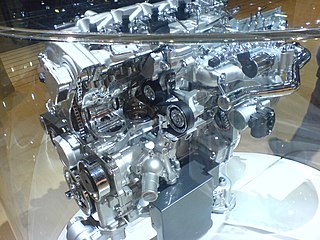
The Toyota AD engine family is a series of 16 valve DOHC inline-4 turbo diesel engines with electronic common rail direct injection using an aluminium cylinder head and an aluminium cylinder block with cast iron liners derived from the petrol Toyota AZ engine. The AD engine is offered in 2.0 and 2.2 liter versions. These engines are produced mainly for Europe, but few are exported to other areas such as India or New Zealand.

The YD engine is a 2.2 and 2.5 L inline-four diesel engine from Nissan. It has a cast-iron block and aluminium head with chain driven twin overhead camshafts. The engine shares much of its architecture with the QR petrol engine.
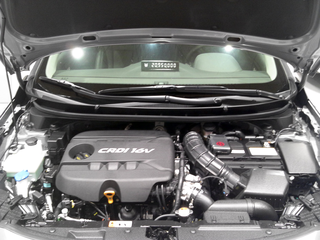
The Hyundai U engine is a series of three or four-cylinder diesel engines made for automotive applications by the Hyundai Kia Automotive Group. The U series of engines includes the smallest automotive diesel engines produced by Hyundai.


















